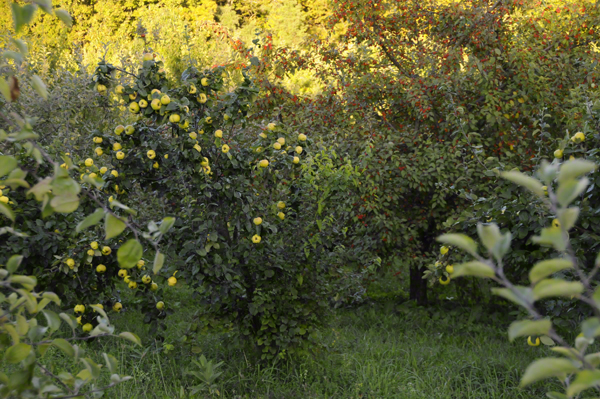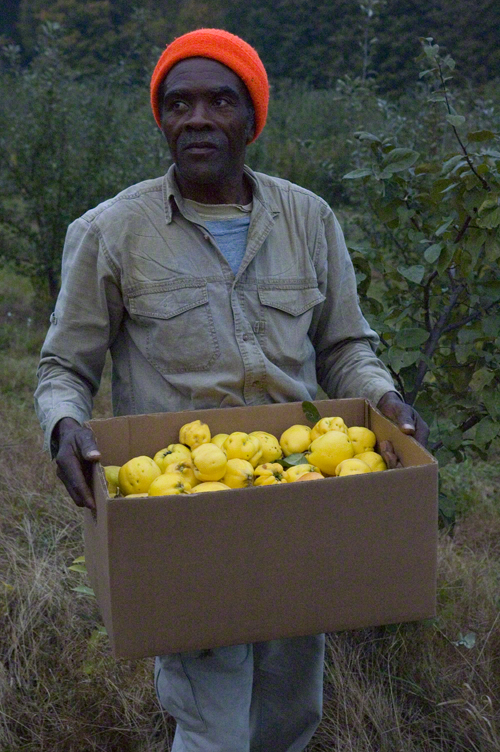Here are some of the titles we return to again and again to refresh our memories on fruits tart and sweet when we are lacking fruits to eat.
We are very careful with two collectible and historic guides to apples:
The Fruits and Fruit Trees of America; the culture, propagation, and management, in the garden and orchard, of fruit trees generally; with descriptions of all the finest varieties of fruit, native and foreign, cultivated in this country by A.J. Downing and corresponding member of the Royal Botanic Society of London; and of the horticultural societies of Berlin; the Low Countries; Massachusetts; Pennsylvania; Indiana; Cincinati, etc. – now that’s a mouthful!
The Apples of New York, Volumes I and II, S.A. Beach assisted by N.O. Booth and O.M. Taylor, Report of the New York Agricultural Experiment Station for the Year 1903.
More contemporary books are noted below.
Our two favorite sources are listed first.
The New Book of Apples by Joan Morgan, Alison Richards, and Elisabeth Dowle. Their publisher, Ebury Press, calls it “the definitive guide to apples, including over 2,000 varieties.
When we can’t find what we are looking for in The New Book of Apples, we grab
Fruit, Berry and Nut Inventory edited by Kent Whealy and published by Seed Savers Exchange of Decorah, Iowa. We have the third edition published in 2001 and know we need to upgrade soon.
Old Southern Apples by Creighton Lee Calhoun, Jr. The revised and expanded edition is published by Chelsea Green.
Also by Chelsea Green, Michael Phillips The Apple Grower, A Guide for the Organic Orchardist. We do not own a second book by Phillips, The Holistic Orchard: Tree Fruits and Berries the Biological Way, but imagine it is just as good as the first.
A cute little book with great drawings and descriptions of heirloom apples is by Roger Yepsen and simply titled Apples. W.W. Norton & Company published this book in 1994 but it is still a treasure.
A new book on our desk is The Illustrated World Encyclopedia of Apples: A comprehensive guide to over 400 varieties accompanied by 60 scrumptious recipes by Andrew Mikolajski and published by Lorenz books.
Apple of Your Pie: A Collection of Apple Pie Recipes and the History of Apple Growing in America by Eileen Maher Kronauer and Charles Kronauer. We found a copy of this interesting book of apples at a sweet little restaurant called Ariana’s in Orford, New Hampshire.
The Apple Source Book; particular uses for diverse apples by Sue Clifford and Angela King with Philippa Davenport, Common Ground
Another fun Common Ground book – Apple Games and Customs.
Orchards written by Claire Masset is great little book – we hope to have it and a sister book, Making Craft Cider, put out by Shire Publications for sale at the farm stand.
Apples; history, folklore, horticulture, and gastronomy by Peter Wynne, Hawthorn Books
Uncommon Fruits Worthy of Attention, A Gardeners Guide by Lee Reich, Addison Wesley Publishing Company
Grow Your Own Fruit, Carol Klein with Simon Akeroyd and Lucy Halsall, an imprint of Octopus Books/Mitchell Beazley
Apple Pie; An American Story, John T. Edge, G.P. Putnam Son’s
An Apple Harvest, recipes and orchard lore by Frank Browning and Sharon Silva, Ten Speed Press
The Origins of Fruit & Vegetables, Jonathan Roberts, Universe
Apples by Frank Browning, North Point Press
The Fruit Hunters; A story of Nature, Adventure, Commerce and Obsession by Adam Leith Gollner, Scribner
The Apple Book, Rosanne Sanders, Philosophical Library, New York in association with The Royal Horticultural Society
Apples, A Cookbook, Quantum Books Ltd
Pomologia from Netherlands/Germany/France/England by Johann Hermann Knoop, 1758 (reprinted FKG)
Burcombes, Queenies and Colloggetts by Virginia Spiers and illustrated by Mary Martin published by West Brendon
Gardener Cook by Christopher Lloyd, Willow Creek Press
A is for Apple, Greg Patent and Dorothy Hinshaw Patent, Broadway Books
Homegrown Fruit, Mimi Luebbermann, Chronicle Books
The Orchard, A Memoir by Adele Crockett Robertson – a truly wonderful book about tough times, Bantam
Henry David Thoreau, Wild Fruits, W.W. Norton and Company
The American Apple Orchard, F.A. Waugh, 1911
The Fruit Garden, A Treatise, P. Barry, 1862
Lipincott’s Farm Manuals – Productive Orcharding by Fred C. Sears, 1914
Please check our post on hard and sweet cider titles.
Please ask Jane Booth for permission to reproduce her copyrighted photographs and/or writing. Email jane.booth.1@gmail.com or call (802) 258-3971. Jane has spent a good part of her career photographing and writing about gardens and small farms for Gardens Illustrated, Yankee Magazine, Country Living, Country Living Gardens, Better Homes & Gardens, New Old House Journal, and Cape Cod & Islands Home where she produced an ongoing column and feature stories.







